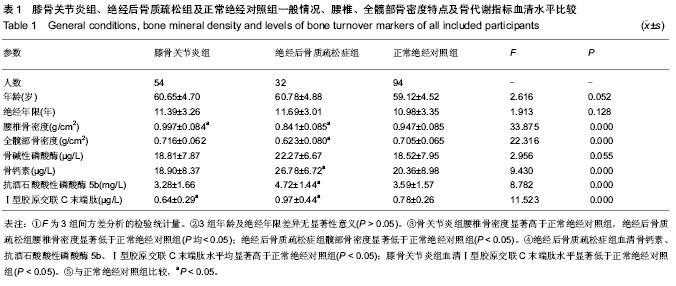| [1] Yoshimura N,Muraki S,Oka H, et al. Prevalence of knee osteoarthritis, lumbar spondylosis,and osteoporosis in Japanese men and women: the research on osteoarthritis/osteoporosis against disability study. Bone Miner Metab. 2009;27(5):620-628.[2] Zhang YQ, Jordan JM. Epidemiology of osteoarthritis. Rheum Dis Clin N Am,2010;26(3):355-369.[3] Dequeker J, Boonen S, Aerssens J, et al. Inverse relationship osteoarthritis-osteoporosis: what is the evidence? What are the consequences? Br J Rheumatology. 1996;35(9): 813-818.[4] Patra D, Sandell LJ. Recent advances in biomarkers in osteoarthritis. Curr Opin Rheumatol. 2011;23(5):465-470.[5] Martínez J, Olmos JM, Hernández JL, et al. Bone turnover markers in Spanish postmenopausal women The Camargo cohort study. Clin Chim Acta. 2009;409(1-2): 70-74.[6] Bay-Jensen AC, Slagboom E, Chen-An P, et al. Role of hormones in cartilage and joint metabolism: understanding an unhealthy metabolic phenotype in osteoarthritis . Menopause. 2013;20(5):578-586.[7] Rousseau JC, Delmas PD. Biological markers in osteoarthritis. Nat Clin Pract Rheumatol. 2007;3(6):346-356.[8] Stewart A , Black A , Robins SP, et al. Bone density and bone turnover in patients with osteoarthritis and osteoporosis. J Rheumatol.1999;(26): 622-626.[9] Silvestri T, Pulsatelli L, Dolzani P, et al. Analysis of cartilage biomarkers in erosive and non erosive osteoarthritis of the hand. Osteoarthritis Cartilage. 2004;12(10):843-845.[10] Karsdal MA, Byrjalsen I, Bay-Jensen AC, et al. Biochemical markers identify influences on bone and cartilage degradation in osteoarthritis - the effect of sex, Kellgren-Lawrence (KL) score, Body Mass Index (BMI), oral salmon calcitonin (sCT) treatment and diurnal variation. BMC Musculoskeletal Disorders. 2010;11:125. [11] World health organization. Guidelines for preclinical evaluation and clinical trials in osteoporosis. 1998.[12] Kellgren JH,Lawrence JS. Radiological accessment of Osteo-Arthrosis. Ann Rheum Dis. 1957;16(4):494-502.[13] Suri P, Morgenroth DC, Hunter DJ. Epidemiology of Osteoarthritis and Associated Comorbidities. PMR. 2012;4(5 Suppl):S10-19.[14] Linn S, Murtaugh B, Casey E. Role of Sex Hormones in the Development of Osteoarthritis. PMR. 2012;4(5 Suppl) : S169-173.[15] Puntus T, Schneider B, Meran J, et al. Influence of age and gender on associations of body mass index with bone mineral density, bone turnover markers and circulating calcium-regulating and bone-active sex hormones . Bone. 2011;49(4):824-829.[16] Peel NF, Barrington NA, Blumsohn A, et al. Bone mineral density and bone turnover in spinal osteoarthrosis. Ann Rheum Dis. 1995;54(11):867-871. [17] El Miedany YM, Mehanna AN, El Baddini MA. Altered bone mineral metabolism in patients with osteoarthritis. Joint Bone Spine. 2000;67(6):521-527.[18] 黄火高, 郑毅, 尹义存.骨性关节炎的定量超声骨密度研究[J].天津医药, 2004, 32(12): 737-739.[19] Alhava EM, Kettunen K, Karjalainen P. Bone mineral in patients with osteoarthrosis of the hip. Acta Orthop Scand. 1975;46(5):709-715.[20] Li B, Aspden RM. Composition and mechanical properties of cancellous bone from the femoral head of patients with osteoarthritis osteoporosis. J Bone Miner Res. 1997;12(4): 641-651.[21] Rousseau JCH, Garnero P. Biological markers in osteoarthritis. Bone. 2012;51(2):265-277.[22] Chopin F, Biver E, Funck-Brentano T. Prognostic interest of bone turnover markers in the management of postmenopausal osteoporosis. Joint Bone Spine. 2012;79(1): 26-31.[23] van Spil WE, DeGroot J, Lems WF, et al. Serum and urinary biochemical markers for knee and hip-osteoarthritis: a systematic review applying the consensus BIPED criteria. Osteoarthritis Cartilage. 2010;18(5):605-612.[24] Ramonda R, Lorenzin M, Modesti V. Serological markers of erosive hand osteoarthritis. Eur J Int Med. 2013;24(1):11-15.[25] Cibere J, Zhang H, Garnero P, et al. Association of Biomarkers with pre-radiographically defined and radiographically defined knee osteoarthritis in a populatio n-based study. Arthritis Rheum. 2009;60(5): 1372-1380.[26] Ichchou L, Allali F, Rostom S, et al.Relationship between spine osteoarthritis, bone mineral density and bone turn over markers in post menopausal women. BMC Womens Health. 2010;10:25.[27] Tascioglu F, Colak O, Armagan O, et al. The treatment of osteoporosis in patients with rheumatoid arthritis receiving glucocorticoids: a comparison of alendronate and intranasal salmon calcitonin. Rheumatol Int. 2005;26(1): 21-29.[28] Romero Barco CM, Manrique Arija S, Rodríguez Pérez M. Biochemical Markers in Osteoporosis: Usefulness in Clinical Practice. Reumatol Clin. 2012;8(3) :149-152 .[29] 薛延,张海文,杨立红. 血清骨特异性酸性磷酸酶的临床意义[J]. 中华内分泌代谢杂志,2003,19(6):466-477.[30] Garnero P, Piperno M, Gineyts E, et al. Cross sectional evaluation of biochemical markers of bone, cartilage, and synovial tissue metabolism in patients with knee osteoarthritis: relations with disease activity and joint damage. Ann Rheum Dis. 2001;60(6):619-626.[31] Naguib A, Hossam N, Samy M. The relationship between osteoarthritis of the hands,bone mineral density, and bone turnover markers. Alexandria J Med. 2011;47(2):149-155.[32] Kumm J, Tamm A, Lintrop M, et al. Diagnostic and prognostic value of bone biomarkers in progressive knee osteoarthritis: a 6-year follow-up study in middle-aged subjects. Osteoarthritis Cartilage. 2013;21(6):815-822.[33] Sowers M, Lachance L, Jamadar D, et al. The associations of bone mineral density and bone turnover markers with osteoarthritis of the hand and knee in pre- and perimenopausal women. Arthritis Rheum,1999,42(3): 483-489.[34] Rodrigues AM, Caetano-Lopes J, Vale AC,et al. Low osteocalcin/collagen type I bone gene expression ratio is associated with hip fragility fractures.Bone. 2012;51(6): 981-989.[35] Jiang LS, Zhang ZM, Jiang SD, et al. Differential Bone Metabolism Between Postmenopausal Women With Osteoarthritis and Osteoporosis. J Bone Miner Res. 2008;23(4):475-483. |

